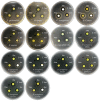LED Lights Influenced Phytochemical Contents and Biological Activities in Kale (Brassica oleracea L. var. acephala) Microgreens
- PMID: 37759989
- PMCID: PMC10525181
- DOI: 10.3390/antiox12091686
LED Lights Influenced Phytochemical Contents and Biological Activities in Kale (Brassica oleracea L. var. acephala) Microgreens
Abstract
Light-emitting diodes (LEDs) are regarded as an effective artificial light source for producing sprouts, microgreens, and baby leaves. Thus, this study aimed to investigate the influence of different LED lights (white, red, and blue) on the biosynthesis of secondary metabolites (glucosinolates, carotenoids, and phenolics) and the biological effects on kale microgreens. Microgreens irradiated with white LEDs showed higher levels of carotenoids, including lutein, 13-cis-β-carotene, α-carotene, β-carotene, and 9-cis-β-carotene, than those irradiated with red or blue LEDs. These findings were consistent with higher expression levels of carotenoid biosynthetic genes (BoPDS and BoZDS) in white-irradiated kale microgreens. Similarly, microgreens irradiated with white and blue LEDs showed slightly higher levels of glucosinolates, including glucoiberin, progoitrin, sinigrin, and glucobrassicanapin, than those irradiated with red LEDs. These results agree with the high expression levels of BoMYB28-2, BoMYB28-3, and BoMYB29 in white- and blue-irradiated kale microgreens. In contrast, kale microgreens irradiated with blue LEDs contained higher levels of phenolic compounds (gallic acid, catechin, ferulic acid, sinapic acid, and quercetin). According to the total phenolic content (TPC) and 2,2-diphenyl-1-picrylhydrazyl (DPPH) inhibition assays, the extracts of kale microgreens irradiated with blue LEDs had slightly higher antioxidant activities, and the DPPH inhibition percentage had a positive correlation with TPC in the microgreens. Furthermore, the extracts of kale microgreens irradiated with blue LEDs exhibited stronger antibacterial properties against normal pathogens and multidrug-resistant pathogens than those irradiated with white and red LEDs. These results indicate that white-LED lights are suitable for carotenoid production, whereas blue-LED lights are efficient in increasing the accumulation of phenolics and their biological activities in kale microgreens.
Keywords: LED lights; antibacterial effect; antioxidant effect; carotenoid; glucosinolate; kale microgreens; phenolics.
Conflict of interest statement
The authors declare no conflict of interest.
Figures



Similar articles
-
Morphological and Photosynthetic Parameters of Green and Red Kale Microgreens Cultivated under Different Light Spectra.Plants (Basel). 2023 Nov 8;12(22):3800. doi: 10.3390/plants12223800. Plants (Basel). 2023. PMID: 38005697 Free PMC article.
-
Light Intensity and Photoperiod Affect Growth and Nutritional Quality of Brassica Microgreens.Molecules. 2022 Jan 28;27(3):883. doi: 10.3390/molecules27030883. Molecules. 2022. PMID: 35164148 Free PMC article.
-
The effect of LED light quality on the carotenoid metabolism and related gene expression in the genus Brassica.BMC Plant Biol. 2023 Jun 21;23(1):328. doi: 10.1186/s12870-023-04326-4. BMC Plant Biol. 2023. PMID: 37340342 Free PMC article.
-
Improving the Health-Benefits of Kales (Brassica oleracea L. var. acephala DC) through the Application of Controlled Abiotic Stresses: A Review.Plants (Basel). 2021 Nov 29;10(12):2629. doi: 10.3390/plants10122629. Plants (Basel). 2021. PMID: 34961097 Free PMC article. Review.
-
Changes in Functional Compounds, Volatiles, and Antioxidant Properties of Culinary Herb Coriander Leaves (Coriandrum sativum) Stored Under Red and Blue LED Light for Different Storage Times.Front Nutr. 2022 May 12;9:856484. doi: 10.3389/fnut.2022.856484. eCollection 2022. Front Nutr. 2022. PMID: 35634386 Free PMC article. Review.
Cited by
-
Biophotonic (nano)structures: from fundamentals to emerging applications.RSC Adv. 2025 Jul 22;15(32):26138-26172. doi: 10.1039/d5ra03288a. eCollection 2025 Jul 21. RSC Adv. 2025. PMID: 40697453 Free PMC article. Review.
-
Antioxidative Response and Phenolic Content of Young Industrial Hemp Leaves at Different Light and Mycorrhiza.Plants (Basel). 2024 Mar 14;13(6):840. doi: 10.3390/plants13060840. Plants (Basel). 2024. PMID: 38592854 Free PMC article.
-
LED light effect on growth, pigments, and antioxidants of lettuce (Lactuca sativa L.) baby greens.BMC Plant Biol. 2025 May 3;25(1):582. doi: 10.1186/s12870-025-06621-8. BMC Plant Biol. 2025. PMID: 40319250 Free PMC article.
-
Metabolite Profiling and Antimicrobial Activities of Brassica rapa ssp. narinosa (Tatsoi), Brassica rapa var. narinosa × chinensis (Dacheongchae), and Brassica rapa ssp. chinensis (Pakchoi).Molecules. 2025 Apr 10;30(8):1693. doi: 10.3390/molecules30081693. Molecules. 2025. PMID: 40333623 Free PMC article.
-
Light regulates the synthesis and accumulation of plant secondary metabolites.Front Plant Sci. 2025 Aug 4;16:1644472. doi: 10.3389/fpls.2025.1644472. eCollection 2025. Front Plant Sci. 2025. PMID: 40831721 Free PMC article. Review.
References
-
- Sikora E., Bodziarczyk I. Composition and antioxidant activity of kale (Brassica oleracea L. var. acephala) raw and cooked. Acta Sci. Pol. Technol. Aliment. 2012;11:239–248. - PubMed
-
- Ayaz F.A., Glew R.H., Millson M., Huang H., Chuang L., Sanz C., Hayırlıoglu-Ayaz S. Nutrient contents of kale (Brassica oleraceae L. var. acephala DC.) Food Chem. 2006;96:572–579. doi: 10.1016/j.foodchem.2005.03.011. - DOI
-
- Lučić D., Pavlović I., Brkljačić L., Bogdanović S., Farkaš V., Cedilak A., Nanić L., Rubelj I., Salopek-Sondi B. Antioxidant and Antiproliferative Activities of Kale (Brassica oleracea L. var. acephala DC.) and Wild Cabbage (Brassica incana Ten.) Polyphenolic Extracts. Molecules. 2023;28:1840. doi: 10.3390/molecules28041840. - DOI - PMC - PubMed
-
- da Silva L.C.R., Azevedo A.M., Almeida A.C., da Fonseca F.S.A., Brandi I.V., Ferreira E.A., Fernandes A.C.G., Valadares N.R. Antioxidant and antimicrobial capacity of aqueous extract of kale and potential supplementation in fermented dairy beverage. Sci. Plena. 2021;17:101502. doi: 10.14808/sci.plena.2021.101502. - DOI
Grants and funding
LinkOut - more resources
Full Text Sources
Molecular Biology Databases

